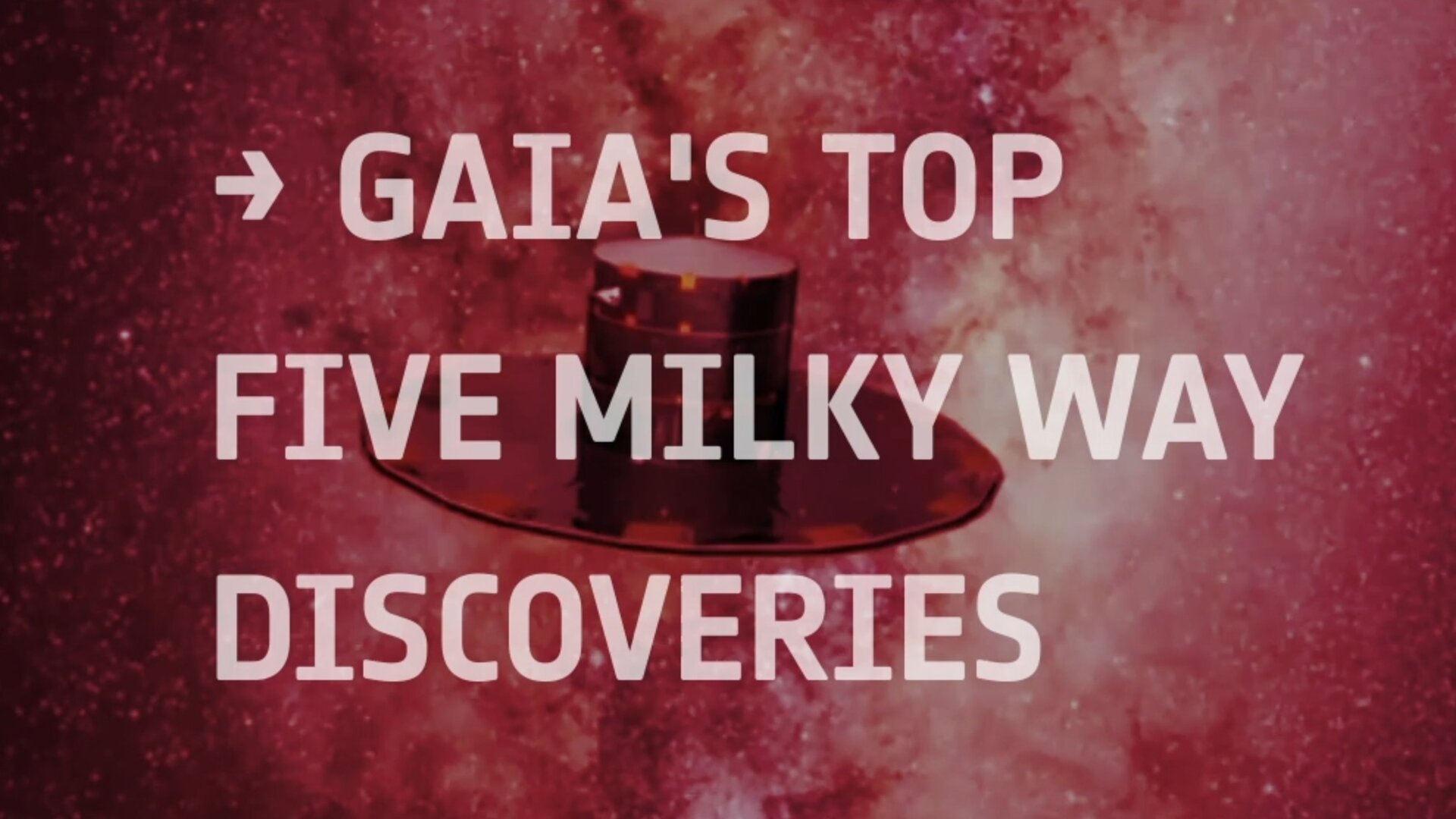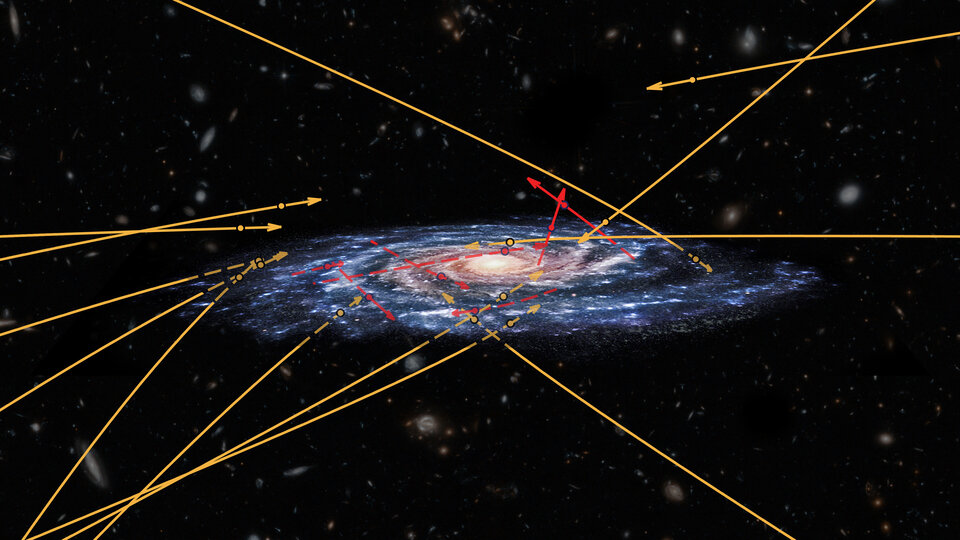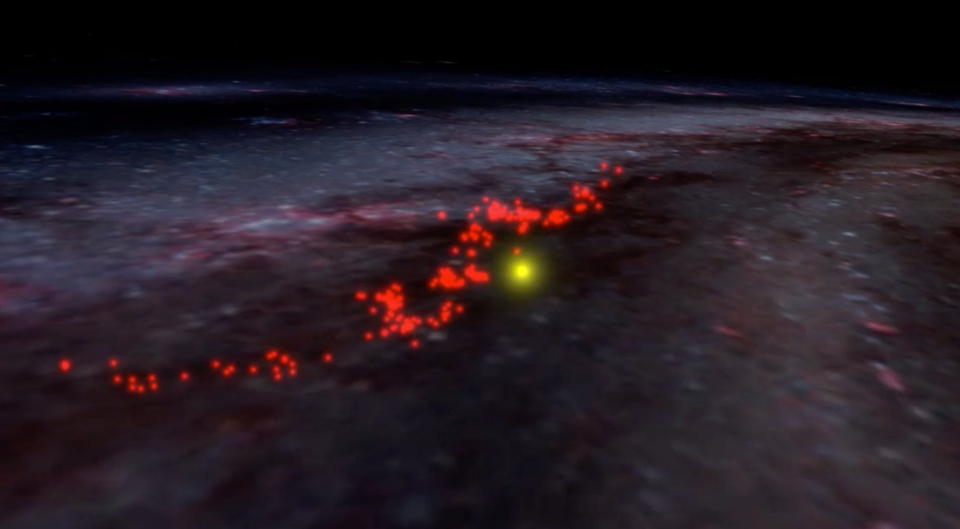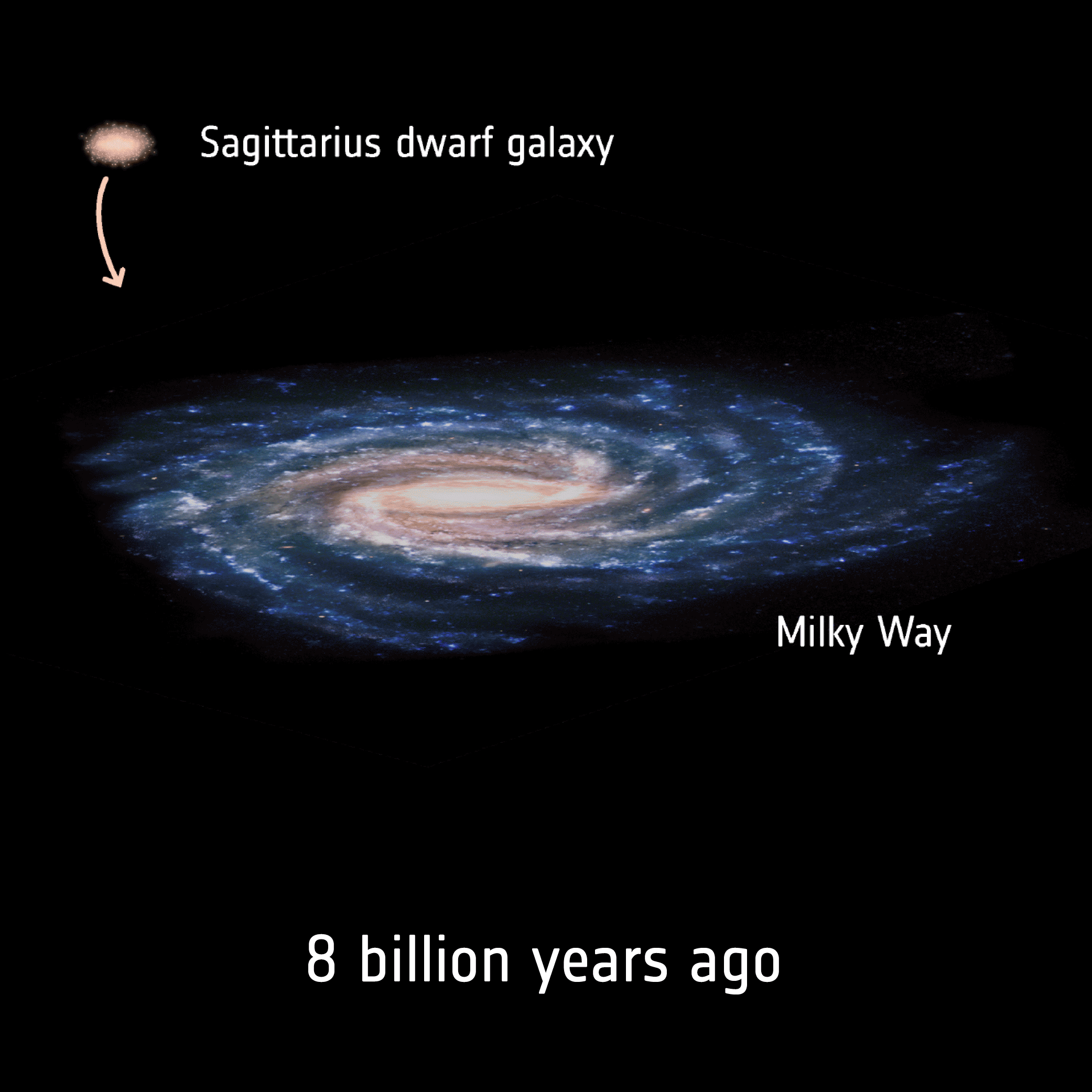Five fascinating Gaia revelations about the Milky Way
With its two releases of data in September 2016 and April 2018, Gaia has truly revolutionised the study of the Milky Way. It ushered in the golden age of galactic archaeology, a discipline that searches for evidence of past galactic events in the characteristics and behaviour of stars and stellar populations that we see today. Gaia does not only reveal details of the Galaxy’s structure. The mission creates an awe-inspiring astronomical movie reconstructing the Milky Way’s evolution to the past and future over billions of years. Here are the five interesting discoveries that Gaia has made about the galaxy that we are part of.
1. The Milky Way is a galactic cannibal


Access the video
Astronomers have suspected since the 1990s that the Milky Way was born out of collisions between smaller galaxies that had taken place over the billions of years of its history. Earth-based telescopes, such as the Sloan Digital Sky Survey, provided first hints of the galaxy’s violent past, but it wasn’t until Gaia that astronomers could really deconstruct the processes that led to the creation of the Universe that surrounds us.
In 2018, a team from the University of Groningen, the Netherlands, led by galactic archaeology expert Amina Helmi, discovered that a group of 30 000 stars moves in a synchronised way through the neighbourhood of the Sun in the opposite direction to the rest of their sample of seven million stars.
This atypical motion pattern matched what the scientists had previously observed in computer simulations modelling galactic collisions and mergers.
These stars also stood out in the so-called Hertzsprung-Russell diagram, which compares the colour and brightness of stars, indicating that they come from a different stellar population, that is, from another galaxy.
“The collection of stars we found with Gaia has all the properties of what you would expect from the debris of a galactic merger,” says Amina.
Further analysis confirmed that the stars, which now form part of the Milky Way’s so-called inner halo and the outer layer of the galactic disc, must have originated from another galaxy. This galaxy, since nicknamed Gaia-Enceladus, must have collided with the Milky Way some 10 billion years ago. About the size of one of the Magellanic Clouds (two satellite galaxies roughly ten times smaller than the current size of the Milky Way), Gaia-Enceladus smashed into and was gradually devoured by the Milky Way, which was at that time only four times bigger than Gaia-Enceladus. The collision, therefore, must have profoundly shaken the Milky Way.
The Milky Way’s violent history, however, didn’t end with Gaia-Enceladus. In 2019, astronomers discovered in the Gaia data a signature of another collision with a smaller galaxy, since then nicknamed Sequoia, which had hit the Milky Way’s galactic disc not long after Gaia-Enceladus.
2. Stars form in the Milky Way because of a galactic crash
Gaia has also shed light on the interactions with the dwarf galaxy Sagittarius, which has been orbiting around the Milky Way’s core for billions of years.
Discovered in the 1990s, Sagittarius contains only a few tens of millions of stars (compared to the Milky Way’s hundreds of billions), which makes it 10 000 times less massive than the Milky Way. As the Milky Way’s gravity pulled Sagittarius closer, the smaller galaxy started smashing through the Milky Way’s disc. That happened at least three times in the past: some five or six billion years ago, two billion years ago, and one billion years ago. With each collision, the Milky Way stripped stars from Sagittarius, leaving the dwarf galaxy smaller and smaller. Eventually, Sagittarius will be completely devoured by the Milky Way. Yet, the dwarf has a profound effect on its larger cannibal.
The perhaps most curious aspect of Sagittarius’ interaction with the Milky Way was described in a paper published in the spring of 2020. A team of researchers from the Instituto de Astrofísica de Canarias (IAC) in Tenerife, Spain, found that in the wake of each Sagittarius’ crash through the Milky Way’s disc, stars formation in the galaxy accelerated. In fact, one of those periods roughly coincided with the formation of the Sun and the Solar System some 4.7 billion years ago.
The researchers believe that each collision caused ripples in the interstellar medium, like a rock thrown into water. As a result, the concentration of gas and dust in some areas of the Milky Way increased to the level that triggered star formation.
“After an initial violent epoch of star formation, partly triggered by an earlier merger, the Milky Way had reached a balanced state in which stars were forming steadily,” says Tomás Ruiz-Lara, the lead author of the study. “The galaxy was relatively quiet. Suddenly, Sagittarius fell in and disrupted the equilibrium, causing all the previously still gas and dust inside the larger galaxy to slosh around like ripples in water.”
The research builds on a 2019 study by a team from the University of Barcelona, Spain, which calculated the true size and brightness of millions of stars observed by Gaia. From the information about the size and brightness, astronomers could deduce the age of individual stars. The study concluded that star formation in the Milky Was had been declining since its formation until about five billion years ago when it suddenly ramped up.
Up to half of the total mass of all the stars ever created in the Milky Way’s thin disk, which contains most of the Galaxy’s stars, was produced during this period.
It now appears that without the infall of the relatively small Sagittarius dwarf galaxy, the Milky Way would have looked very different today and would have had much fewer stars.
“This is really the first time that we see a detailed star formation history of the Milky Way,” says ESA Gaia mission project scientist Timo Prusti. “It is a testament to the scientific power of Gaia that we have seen manifest again and again in countless ground-breaking studies in a period of only a couple of years.”
3. The Milky Way’s arms and disc are alive

Before Gaia, astronomers were limited in their attempts to study the structure of the Milky Way. They knew that the Milky Way was a so-called spiral galaxy – a pancake-like disc of stars with a pattern of spiral arms rotating around a much denser core.
The spiral arms are areas of densely packed gas and stellar matter that appear, when observed in other galaxies, in bluer shades than the rest of the disc, which indicates the hotter temperature of the stars within them. Since hot stars are massive stars and since massive stars are young stars, astronomers can tell that spiral arms are areas where stars are being formed.
“Before Gaia, we didn’t know whether there were two or four spiral arms in the Milky Way,” says Sergey Khoperskov, an astrophysicist at the Max Planck Institute for Extraterrestrial Physics in Germany. “Now we have clear evidence that there are four of them. With Gaia, we can measure the distance to the stars and see where they are more densely packed together, which is an indication of a spiral arm.”
The Sun is located in one of the two smaller arms, named the Orion arm, some 26 000 light years away from the Milky Way’s centre, completing one rotation around the centre in about 230 million years.
In a paper published in January 2020, Sergey and his colleagues looked at patterns in the density of stars in the Milky Way and compared those with previously available information.
“We identified several areas of stellar overdensities and we compared those with the previously known location of the Milky Way’s spiral arms,” says Sergey. “I think it is for the first time in the literature that we found stellar overdensities in such a large scale, in the region of about 10 to 13 thousand light years from the Sun. This is the biggest picture of the Milky Way’s spiral arms based directly on the observation of stars.”
The nature of the spiral structure in galaxies such as the Milky Way has been a matter of debate since its first hints were mapped by Jan Oort using radio wave observations in the 1950s.
“There are several theories for spiral-arm structure formation,” says Sergey. “Many astronomers believe that spiral arms are short-lived structures caused by some sort of gravitational instability and that they disappear within a couple of rotations and then re-emerge with some different pattern.”
“Once we identify individual stars in the spiral arms, we will be able to understand the origin,” Sergey adds. “Since we know the structure, we know the position, we know the distribution, we may have a look at the chemical composition patterns and we can try to understand all that information better.”
According to ESA Gaia deputy project scientist Jos de Bruijne, spiral arms do not contain the same stars throughout their billions years of existence. He describes spiral arms like traffic jams, areas where stars concentrate while waiting to squeeze through some sort of a bottleneck.
“Stars are moving out at the front but the traffic jam stays because stars are piling up at the back,” he says. “We still don’t know exactly why these traffic jams form and I am convinced that Gaia will shed light on this.”
In addition to these main structures, research based on Gaia data has revealed that the entire disc of the galaxy is alive and moving in many different ways and directions as a result of the various forces that act within the galaxy. The Milky Way is constantly being disturbed by other bodies, dwarf galaxies and stellar clusters, that orbit around it. These interactions leave lasting imprints on the Milky Way, which can be observed hundreds of millions of years later. For example, in 2018, a team from the University of Barcelona found a group of millions of stars following a snail-shape position and motion pattern in the Milky Way’s disc. Their calculations revealed that this ripple was most probably a result of one of the past collisions with the Sagittarius dwarf galaxy.
The periodic collisions with Sagittarius are believed to have had a profound effect on how stars move in the Milky Way. Some even claim that the 10 000 times more massive Milky Way’s trademark spiral structure might be a result of the crashes with Sagittarius.
4. The Milky Way strips and catches stars from other galaxies and clusters

The Milky Way is also constantly stripping stars from dwarf galaxies and stellar clusters with which it interacts. Based on Gaia data, astronomers have identified streams of stars ripped from these bodies that frequently stretch over distances of thousands of light-years, covering a large portion of the sky above our heads.
Data about such streams can help astronomers assess the gravitational force and therefore the mass distribution of the Milky Way and hence reveal how galaxies acquire stars.
Gaia has also found stars in the Milky Way’s disc that are travelling at such high speeds that they might be able to escape the galaxy’s gravitational pull or might have been expelled from other galaxies and subsequently captured by the Milky Way.
“Of the seven million Gaia stars with full 3D velocity measurements, we found twenty that could be travelling fast enough to eventually escape from the Milky Way,” explains Elena Maria Rossi, from Leiden University, the Netherlands, one of the authors of a recent study. “But rather than flying away from the galactic centre, most of the high-velocity stars we spotted seem to be racing towards it.”
It is possible that these intergalactic interlopers come from the Large Magellanic Cloud, a relatively small galaxy orbiting the Milky Way, or they may originate from a galaxy even further afield.
“Stars can be accelerated to high velocities when they interact with a supermassive black hole,” Elena explains. “The presence of these stars might be a sign of such black holes in nearby galaxies. But the stars may also have once been part of a double-star system in another galaxy, flung towards the Milky Way when their companion star exploded as a supernova.”
If these stars do come from other galaxies, they would carry the imprint of their place of origin. They could provide unique insight into distant universes that otherwise would be much more difficult to study.
The astronomers, however, admit that these sprinting stars could be native to our Galaxy’s halo, accelerated and pushed inwards through interactions with one of the dwarf galaxies that fell towards the Milky Way during its build-up history. Additional information about the age and composition of the stars could help the astronomers clarify their origin.
“A star from the Milky Way halo is likely to be fairly old and mostly made of hydrogen, whereas stars from other galaxies could contain lots of heavier elements,” says the study’s co-author Tommaso Marchetti. “Looking at the colours of stars tells us more about what they are made of.”
5. The Sun is surfing a mysterious wave of gas in the Milky Way

In 2019, three scientists associated with the Radcliffe Institute for Advanced Studies of Harvard University discovered that interstellar gas clouds in the Sun’s galactic neighbourhood form a 9000 light-years long wave that undulates about 500 light-years above and below the galactic disc. The 400 light-years wide wave is part of what astronomers describe as the Local Arm, a small spiral arm of the Milky Way close to the Sun.
Interstellar gas clouds interest researchers because they give birth to stars when they collapse. Prior to the 2019 discovery, it was believed that such clouds in the solar neighbourhood are concentrated in the so-called Gould Belt, a ring of young stars, gas, and dust which arches above and below the galactic plane.
“Instead, what we have observed is the largest coherent gas structure we know of in the galaxy, organised not in a ring but in a massive, undulating, narrow and straight filament,” says João Alves, a professor of Stellar Astrophysics at the University of Vienna, a 2018-2019 Radcliffe fellow, and one of the three scientists who discovered the structure, now named the Radcliffe Wave, after the Radcliffe Institute.
The Sun lies only 500 light-years from the wave at its closest and almost appears as if it is surfing it. In fact, according to existing models, the Sun crossed the wave only some 13 million years ago and will cross it again and again in the future.
“The wave has been right in front of our eyes all the time, but we couldn’t see it until now,” João adds.
Alyssa Goodman, Professor of Applied Astronomy and co-director of the Science Program at the Radcliffe Institute of Advanced Study, comments: “We were completely shocked when we first realised how long and straight the Radcliffe Wave is when looking down on it from above in 3D, but also how sinusoidal it is when viewed from Earth. The Wave’s existence is forcing us to rethink our understanding of the Milky Way’s 3D structure.”
The scientists do not know what caused this unexpected, undulating shape. A past collision with a massive body, for example a dwarf galaxy, could be a possible explanation but further studies and more Gaia data are needed to really get a good understanding.
In any case, the findings challenge astronomers to revise theories about the distribution of gas in the Sun’s neighbourhood.


